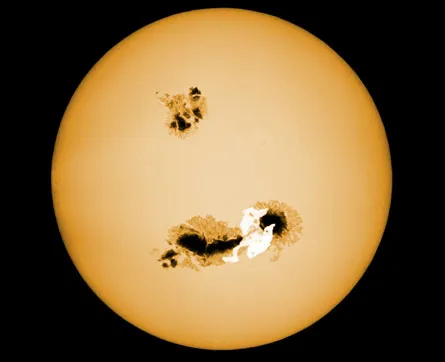Not just a sartorial trend in ’70s trousers, superflares are enormous stellar eruptions that dwarf the most energetic sneeze the sun is likely to produce.

For more than a decade, astronomers thought these outbursts resulted from magnetic interactions between a star and a tightly orbiting, and therefore hot, Jupiter-size planet. But data from NASA’s Kepler spacecraft suggest that while a magnetic trigger does ignite mega-eruptions on sunlike stars, snuggled-up Jupiters don’t appear to be necessary, a team of scientists from Japan reports online May 16 in Nature.
“The default picture of these has been hot Jupiters,” says Bradley Schaefer, an astrophysicist at Louisiana State University. “There’s no alternative [theory] out there.”
Perhaps, Schaefer speculates, a much smaller, close-in planet along the lines of Mercury — which would be harder to detect — could provoke a superflare in its stellar host.
Studying superflares before now has been difficult: They’re transient, relatively infrequent and, though explosive, produce only a small difference in brightness. But the Kepler spacecraft’s unwavering view of 160,000 stars makes it the optimal tool for detecting these outbursts.
To size up the superflares, a team of astronomers from Japan’s Kyoto University studied fluctuations in brightness of roughly 83,000 solar-type stars in the Kepler telescope’s patch of sky. Over 120 days, the researchers saw evidence for 365 superflares on 148 stars, with the average eruption lasting a few hours. The twinkling starlight revealed that stars with starspots — the equivalent of magnetically hyperactive sunspots — produced the flares. “These stars have large starspots, which are much larger than those of our sun,” says astronomer and study coauthor Hiroyuki Maehara.
Although Maehara and colleagues could link the flares with magnetic epicenters, the team didn’t detect any planetary signatures in the peaks and valleys of starry light.
“It looks like very good and careful work,” says Eric Rubenstein, president of the technology development company Image Insight, who developed the hot Jupiter hypothesis while at Yale University in the late 1990s. Rubenstein isn’t too concerned if the stellar companion isn’t a hot Jupiter. “What’s important is that the companion, whatever it is, interacts with the stellar magnetic field,” he says. Any size will do.
Superflares involve a tangled magnetic linkage between star and planet — a tie that becomes twisted, dragged and stressed to the breaking point as the planet orbits. Eventually, the tie snaps like a busted rubber band, slapping the stellar surface and producing a violent eruption. “It’s pretty compelling that it’s some kind of magnetic event,” Rubenstein says.
A superflare from the sun would cripple orbiting satellites — not that anyone would notice, because power grids on Earth would be disrupted as well, Schaefer says. But the sun is unlikely to blow such enormous chunks of energy toward Earth.
How these flares might affect life in a distant planetary system is a matter of speculation, but the trigger planet is no doubt destined for a violent end: It will eventually plunge into the star, as each flare saps some of its orbital energy. “The planet is doomed on a timescale of a billion years,” Schaefer says.







